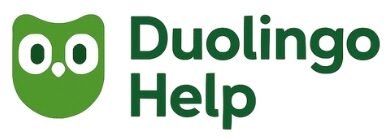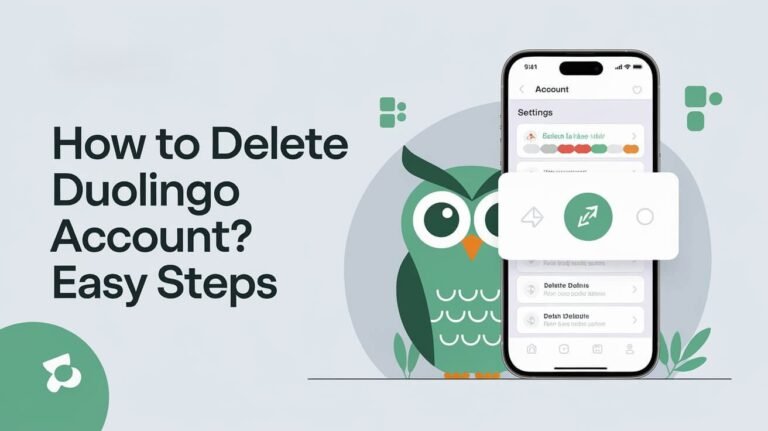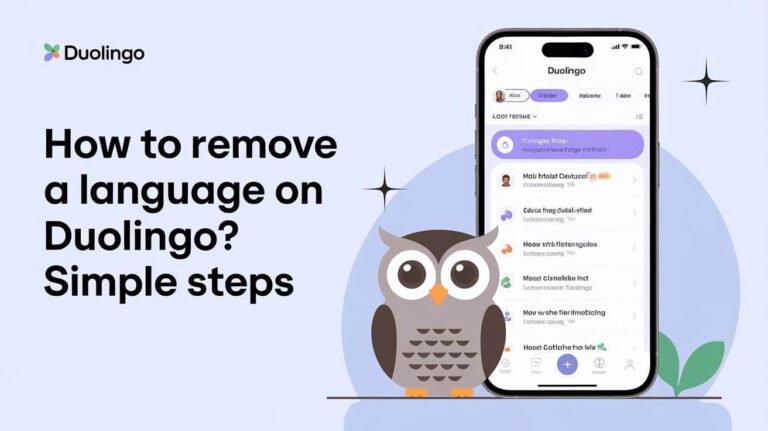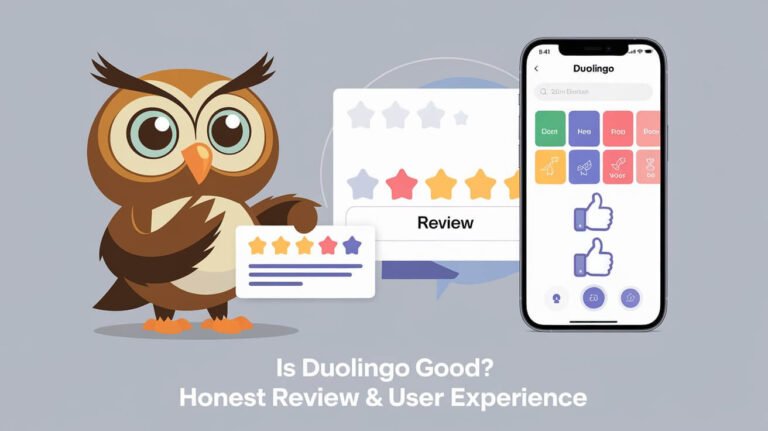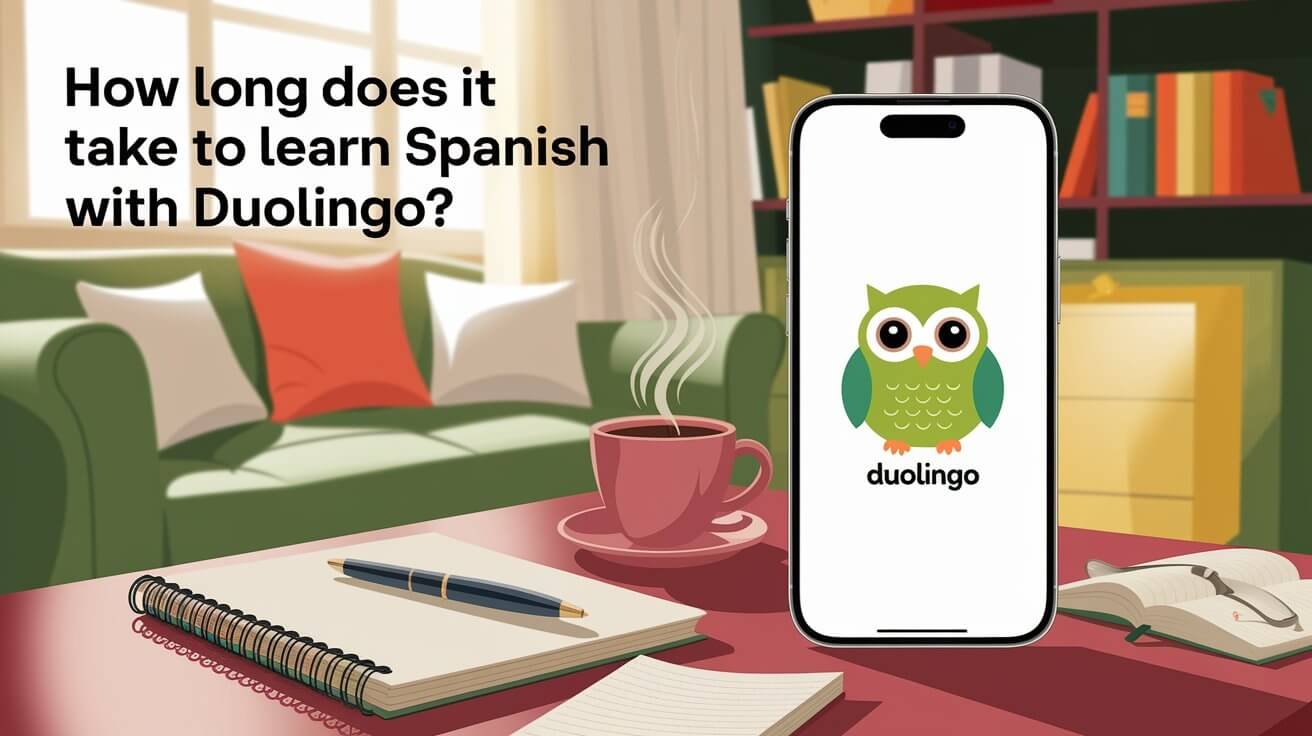
Are you eager to learn Spanish and wondering if Duolingo can help you achieve your goal? Duolingo is a popular language learning app that has gained worldwide recognition for its interactive and user-friendly approach.
With Duolingo, you can start learning Spanish at your own pace, anytime and anywhere. The app offers a comprehensive curriculum that covers reading, writing, and speaking skills, making it an ideal tool for beginners and intermediate learners alike.
Key Takeaways
- Duolingo’s effectiveness in language learning
- Timeframe to reach different Spanish proficiency levels
- Tips to enhance your learning experience
- Factors influencing the learning process
- Combining Duolingo with other learning methods
Spanish Learning Timeframes: Myths vs. Facts
The journey to Spanish fluency is often shrouded in misconceptions about the time it requires. Many learners start their Spanish journey with preconceived notions about how long it should take to become proficient. However, the reality is more nuanced, with various factors influencing the learning process.
Various Proficiency Levels Explained
Language proficiency is typically measured using the Common European Framework of Reference for Languages (CEFR), which defines six levels: A1, A2, B1, B2, C1, and C2. Understanding these levels is crucial for setting realistic goals. The CEFR framework helps learners and educators assess progress and identify areas for improvement.
| CEFR Level | Description |
|---|---|
| A1 | Basic understanding and communication |
| A2 | Improved basic understanding and simple interactions |
| B1 | Independent interaction and understanding of main points |
| B2 | Upper-intermediate level with complex interactions |
| C1 | Advanced proficiency with nuanced understanding |
Duolingo’s Official Estimates
Duolingo uses the CEFR to guide its course development. According to Duolingo estimates, learners can achieve significant progress with consistent practice. Duolingo’s Spanish course is designed to help learners reach the B1 or B2 level, depending on their dedication and practice consistency.
Understanding the language proficiency levels and using tools like Duolingo, learners can better navigate their Spanish learning timeframes. It’s essential to be aware of the myths and facts surrounding language learning to set achievable goals.
Factors That Affect Your Spanish Learning Speed
Several key factors influence how quickly you can learn Spanish with Duolingo. Understanding these elements can help you optimize your learning experience and achieve your goals more efficiently.
Prior Language Experience
Your prior language experience plays a significant role in determining your Spanish learning speed. If you’ve learned a Romance language before, such as French or Italian, you’ll likely find certain aspects of Spanish easier to pick up due to similarities in grammar and vocabulary. This prior knowledge can significantly reduce the time it takes to reach proficiency. For instance, you might already be familiar with verb conjugations or sentence structures that are similar across these languages.
Daily Practice Consistency
Consistency is key when it comes to language learning on Duolingo. The app is designed to work best when used regularly, even if it’s just for a few minutes each day. Daily practice helps reinforce new language skills and prevents forgetting. By making Duolingo a part of your daily routine, you can maintain momentum and make steady progress toward your Spanish learning goals.
Personal Motivation Levels
Your personal motivation levels can greatly impact your learning speed. Staying motivated is crucial, as it directly affects how consistently you practice and how much effort you put into learning. Setting achievable milestones and rewarding yourself for progress can help maintain high motivation levels. Additionally, reminding yourself why you wanted to learn Spanish in the first place can help you stay on track.
| Factor | Impact on Learning Speed | Tips for Improvement |
|---|---|---|
| Prior Language Experience | High | Leverage similarities with languages you already know |
| Daily Practice Consistency | High | Make Duolingo practice a daily habit |
| Personal Motivation Levels | Medium | Set achievable milestones and reward progress |
Duolingo’s Spanish Course Structure
Duolingo’s Spanish course is meticulously structured to guide learners through a progressive journey. This structured approach ensures that learners build a strong foundation in Spanish by gradually introducing new concepts and reinforcing previously learned material.
Course Units and Progression Path
The Spanish course on Duolingo is divided into sections and units that cover various grammar and vocabulary topics. The course is designed to take learners from basic to more advanced levels, with each unit focusing on specific skills such as reading, writing, and speaking.
The progression path is logical and incremental, allowing learners to track their progress and stay motivated. Key features of the course structure include:
- Gradual Introduction of Concepts: New grammar rules and vocabulary are introduced in a logical sequence.
- Repetition and Practice: Regular exercises reinforce learning and help solidify new skills.
- Interactive Lessons: The course includes a variety of interactive lessons to keep learners engaged.
Grammar and Vocabulary Distribution
The distribution of grammar and vocabulary throughout the course is carefully planned to ensure a balanced learning experience. Duolingo’s Spanish course covers a wide range of topics, from basic phrases and grammar rules to more complex sentence structures and nuanced vocabulary.
Some of the key areas of focus include:
- Basic Phrases and Vocabulary: Learners start with common phrases and basic vocabulary.
- Grammar Rules: The course introduces grammar rules in a progressive manner, starting with simple verb conjugations and sentence structures.
- Advanced Topics: As learners progress, they are introduced to more complex grammar and vocabulary, including subjunctive mood and nuanced expressions.
How Long Does It Take To Learn Spanish With Duolingo
Duolingo has made learning Spanish accessible, but understanding the time it takes to reach different proficiency levels is crucial for learners. The timeframe to achieve Spanish fluency with Duolingo depends on various factors, including the learner’s starting level, daily practice consistency, and individual learning pace.
Beginner Level (A1-A2): Typical Timeframe
For beginners, reaching the A1-A2 level, which involves basic understanding and communication, typically takes around 1-3 months with consistent daily practice on Duolingo. At this level, learners can grasp fundamental grammar rules and vocabulary, enabling them to communicate in everyday situations.
Key milestones at this level include understanding common phrases, being able to introduce oneself, and comprehending simple texts.
Intermediate Level (B1-B2): Typical Timeframe
Progressing to the intermediate level (B1-B2) requires more time and effort, typically taking 6-12 months. At this stage, learners can understand more complex texts, engage in conversations with native speakers, and express their opinions more effectively.
The intermediate level is characterized by improved comprehension of nuanced language, the ability to understand different spoken dialects, and enhanced writing skills.
Advanced Level (C1): Is It Possible?
Reaching an advanced level (C1) with Duolingo is challenging but possible with dedicated practice and supplementary learning resources. It can take 1-2 years or more to achieve this level, where learners can understand complex texts, recognize implicit meanings, and express themselves fluently and spontaneously.
To achieve C1 level, learners should supplement their Duolingo practice with reading advanced texts, engaging in conversations with native speakers, and possibly taking formal Spanish courses.
Science Behind Duolingo’s Learning Method
Understanding the science behind Duolingo’s learning method can help learners maximize their progress. Duolingo’s effectiveness in language learning stems from its combination of scientifically-backed techniques.
Spaced Repetition System
Duolingo utilizes a spaced repetition system to optimize vocabulary retention. This method involves reviewing material at increasingly longer intervals to help solidify it in the learner’s long-term memory.
Gamification Elements
The platform incorporates gamification elements to boost learner engagement. Features like points, badges, and leaderboards encourage users to practice consistently and maintain their motivation.
Skill Tree Design Logic
Duolingo’s skill tree design allows learners to progress through levels and unlock new skills. This structured approach helps learners build upon previously acquired knowledge and develop a comprehensive understanding of the language.
Combining these techniques, Duolingo creates a comprehensive learning experience that caters to different learning styles and preferences.
Duolingo vs. Other Spanish Learning Methods
When it comes to learning Spanish, the choice of method can significantly impact the learning speed and overall effectiveness. Duolingo, a popular language learning app, is often compared to traditional classroom learning and immersion programs.
Duolingo offers a flexible and gamified approach to learning Spanish, allowing users to learn at their own pace. In contrast, classroom learning provides a structured environment with direct interaction between students and teachers.
Classroom Learning Speed Comparison
Classroom learning can offer faster progress in certain aspects of language learning, such as speaking and listening, due to the interactive nature of the classes. However, the pace is often dictated by the group’s overall progress.
- Advantages of classroom learning include direct feedback from teachers and social interaction with peers.
- Disadvantages include a fixed schedule and potential difficulties in keeping up with the class pace.
Immersion Programs Speed Comparison
Immersion programs, where learners are surrounded by the language, can lead to rapid improvements in comprehension and speaking skills. This method is particularly effective for achieving fluency.
- Immersion programs offer the opportunity to learn Spanish in context, picking up nuances and expressions naturally.
- However, they can be costly and require significant time commitments.
While Duolingo offers a flexible and engaging way to learn Spanish, classroom learning and immersion programs have their own unique advantages. The choice of method depends on the learner’s goals, schedule, and learning style.
Tactics to Accelerate Your Spanish Progress
To make significant progress in Spanish, it’s essential to adopt strategies that complement your Duolingo practice. While Duolingo provides a solid foundation, incorporating additional learning methods can significantly enhance your learning speed and overall proficiency.
Optimal Daily Practice Patterns
Consistency is key when it comes to language learning. Establishing an optimal daily practice pattern can significantly impact your progress.
Morning vs. Evening Learning
Research suggests that learning in the morning can improve retention due to reduced distractions and a fresher mind. However, the best time to practice is when it fits best into your schedule.
Streak Maintenance Benefits
Maintaining a streak on Duolingo can be a powerful motivator. A consistent daily practice streak helps in developing a habit and ensures continuous progress.
Effective Supplementary Resources
To accelerate your Spanish learning, consider incorporating supplementary resources into your study routine. Some effective resources include:
- Language exchange apps like Tandem or HelloTalk
- Spanish media such as TV shows, movies, and podcasts
- Language learning books and textbooks
Using a combination of these resources can help reinforce your learning and provide a more well-rounded education.
| Resource Type | Description | Benefits |
|---|---|---|
| Language Exchange Apps | Apps that connect you with native speakers for language exchange | Improves speaking skills, provides cultural insights |
| Spanish Media | TV shows, movies, podcasts, and music in Spanish | Enhances listening skills, exposes you to different accents |
| Language Learning Books | Textbooks, grammar guides, and vocabulary builders | Provides structured learning, useful for grammar clarification |
Real-World Practice Integration
Integrating real-world practice into your learning can significantly enhance your fluency. Engage in conversations with native speakers, watch Spanish media, and use Spanish in your daily life. This practical application of your knowledge helps solidify your understanding and builds confidence in your language abilities.
Common Roadblocks in Spanish Learning
Learning Spanish with Duolingo can be a rewarding experience, but it’s not without its challenges. As learners progress through the course, they may encounter certain obstacles that can hinder their progress. Understanding these common roadblocks can help learners prepare and overcome them.
The Intermediate Plateau
One of the most significant challenges learners face is the intermediate plateau. At this stage, learners may feel like they’re not making progress despite their continued efforts. This plateau can be attributed to several factors, including:
- Limited exposure to authentic materials
- Insufficient practice in real-life conversations
- A lack of challenging content
To overcome the intermediate plateau, learners can try engaging with native speakers, watching Spanish media, or reading Spanish literature to enhance their exposure and challenge their skills.
Motivation Dips and Solutions
Another common roadblock is motivation dips. Learners may start with high enthusiasm, but as time passes, their motivation can wane. To combat this, learners can:
- Set achievable milestones and reward themselves upon reaching them
- Join a language learning community for support and motivation
- Vary their learning routine to keep it interesting
Recognizing the potential for motivation dips and implementing strategies to stay motivated, learners can maintain their momentum and continue making progress in their Spanish learning journey.
Real User Data: Spanish Fluency Achievements
Real user data provides valuable insights into the effectiveness of Duolingo for Spanish learning. By examining the experiences of actual users, we can better understand the platform’s capabilities and limitations.
Success Stories and Actual Timeframes
Many Duolingo users have achieved Spanish fluency and shared their success stories. For instance, some users have reported reaching intermediate levels within 6-12 months of consistent practice. These user success stories demonstrate the potential of Duolingo for language learning.
| Proficiency Level | Typical Timeframe | Number of Users |
|---|---|---|
| Beginner (A1-A2) | 3-6 months | 10,000+ |
| Intermediate (B1-B2) | 6-12 months | 5,000+ |
| Advanced (C1) | 1-2 years | 1,000+ |
Realistic Expectations From User Experiences
While Duolingo has helped many users achieve Spanish fluency achievements, it’s essential to have realistic expectations. User experiences vary widely, and factors such as prior language experience and daily practice consistency play a significant role in determining progress.
Understanding the experiences of other users, learners can set achievable goals and stay motivated throughout their language learning journey.
Conclusion
Learning Spanish with Duolingo is a multifaceted process influenced by various factors, including prior language experience, daily practice consistency, and personal motivation levels. Throughout this article, we’ve explored the intricacies of Spanish learning timeframes, debunking myths and presenting facts about achieving different proficiency levels.
Duolingo’s Spanish course is structured to guide learners through a progression path, distributing grammar and vocabulary effectively. The platform’s spaced repetition system, gamification elements, and skill tree design logic contribute to its effectiveness in language acquisition.
While Duolingo offers a robust learning framework, accelerating Spanish progress requires optimal daily practice patterns, supplementary resources, and real-world practice integration. Understanding common roadblocks, such as the intermediate plateau and motivation dips, helps learners navigate their journey more effectively.
Real user data and success stories demonstrate that achieving Spanish fluency with Duolingo is attainable, with actual timeframes varying based on individual factors. By synthesizing these insights, learners can set realistic expectations and stay motivated throughout their Spanish learning journey with Duolingo.
FAQs
How long does it take to become fluent in Spanish with Duolingo?
The time it takes to become fluent in Spanish with Duolingo depends on various factors, including prior language experience, daily practice, and motivation. However, with consistent practice, you can reach conversational fluency in a few months.
Is Duolingo enough to learn Spanish?
Duolingo is a great tool to learn Spanish, but it’s not enough on its own. Supplementing Duolingo with other resources, such as language exchange programs, TV shows, and movies in Spanish, can help you achieve fluency faster.
How many minutes a day should I practice Spanish on Duolingo?
The ideal daily practice time on Duolingo varies, but aiming for 15-30 minutes a day can help you make consistent progress. You can also try to practice in shorter intervals, such as 5-10 minutes, several times a day.
Can I reach advanced levels of Spanish proficiency with Duolingo?
Yes, it’s possible to reach advanced levels of Spanish proficiency with Duolingo, but it requires consistent practice and dedication. Duolingo’s advanced courses cover complex grammar and vocabulary, and supplementing with other resources can help you achieve advanced fluency.
How does Duolingo’s spaced repetition system work?
Duolingo’s spaced repetition system reviews material at increasingly longer intervals to help solidify it in your long-term memory. This helps to prevent forgetting and ensures that you retain what you’ve learned.
Can I use Duolingo to prepare for Spanish language proficiency tests?
Yes, Duolingo can be a useful tool to prepare for Spanish language proficiency tests, such as the DELE. Duolingo’s courses cover a wide range of grammar and vocabulary, and its interactive exercises can help you practice your reading, writing, and listening skills.
How does Duolingo compare to other language learning methods?
Duolingo is a unique language learning platform that combines gamification, interactive exercises, and spaced repetition. While it’s not a replacement for traditional classroom learning or immersion programs, it can be a valuable supplement to these methods or a standalone tool for those who prefer self-paced learning.
What are some common challenges learners face when using Duolingo to learn Spanish?
Common challenges learners face when using Duolingo to learn Spanish include staying motivated, overcoming the intermediate plateau, and finding opportunities to practice speaking and listening. Duolingo’s community features and supplementary resources can help learners overcome these challenges.
